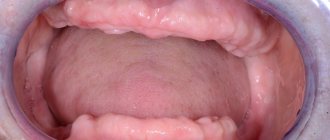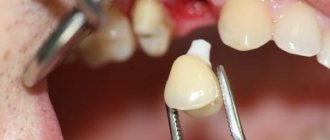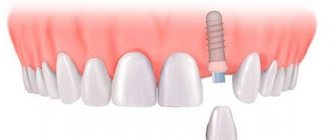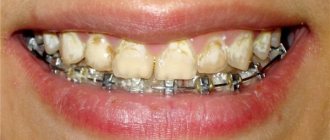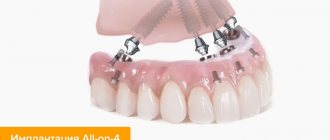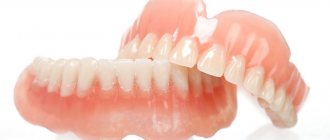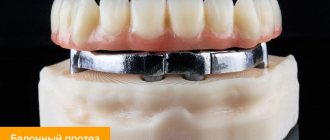A significant proportion of people begin to rapidly lose teeth over the age of 60 - teeth become loose and fall out. For some, tooth loss leads to complete edentia - loss of teeth on both jaws. Removable dentures will help eliminate the problem in case of complete absence of teeth. They are much cheaper than implantation, and they are also used for people with contraindications to surgery.
Features of prosthetics
Dental prosthetics in the absence of teeth involves fixing the structure to the gums. Thanks to its smooth surface, the denture adheres better to the gum shell - thus it is attached to the oral cavity.
Each removable denture has its own lifespan, but on average they are used for five to seven years. Patients quite easily find out that the prosthesis is unsuitable - as soon as it stretches and begins to hold less tightly, it is necessary to consult a doctor for correction.
The service life of a removable denture, its ability to deform and many other functional characteristics depend on the type of product. Methods for dental prosthetics in case of large absence of teeth are different, much depends on the condition of the bone tissue, the presence of gum pathologies (gingivitis, periodontitis, periodontal disease).
The pricing policy in this area of dental services also requires careful study - it is important for a person to choose an option to solve the problem at a price that is acceptable to him.
Contraindications
Teeth can fall out for various reasons:
- Age-related wear of dentin and enamel;
- Periodontal diseases;
- Ignoring doctors;
- Chronic diseases and injuries;
- Failure to comply with oral hygiene rules.
Complete absence of teeth is a serious pathology with many consequences, which threatens:
- Diseases of the gastrointestinal tract due to poor nutrition and incomplete chewing of food.
- Unpleasant changes in appearance: sunken lips and cheeks, sharp nasolabial folds, a strongly protruding chin.
- Severe diction impairments, since teeth are an important part of the articulatory apparatus.
- Changes in gum bone tissue.
This leads to significant psychological discomfort in the patient. He limits his needs: social circle, work, normal nutrition. Only complete dental prosthetics will help him return to a full life.
Diseases due to which prosthetics cannot be performed:
- Allergic reaction to elements present in manufacturing materials;
- Intolerance to anesthesia, which is especially important during implantation;
- Viral infections;
- Severe diabetes mellitus;
- Oncology;
- Exacerbation of mental and neurological diseases;
- Blood clotting disorder;
- Exhaustion of the body and anorexia.
Before starting prosthetics in the absence of teeth, the doctor must check the absence of these diseases in the patient. Some contraindications are temporary, while others become irrelevant when the recovery method changes.
Plate structures
Plate removable dentures are the most budget option. Such products are created from a fairly hard plastic material, which is why they do not fit very tightly to the gums.
Since they are quite massive, they take a long time to get used to. At first, a speech impediment appears, the gums become chafed, and the removable denture needs to be replaced with a more comfortable option.
The procedure for dental prosthetics in case of partial absence of teeth with a plate system is possible - then it is placed on healthy teeth, but this does not improve its performance. Food gets into the gaps, there is a need to often remove it for cleaning, and discomfort is often felt due to a loose fit. The advantages of plastic products are as follows:
- have a low price;
- easy to manufacture, the patient quickly receives the desired design;
- there is a possibility of repair;
- easy to care for, it can be removed and washed without any problems.
Plastic is in great demand, and allergies to the material rarely occur.
Advantages and disadvantages
Conditionally removable prosthetics on implants is a technique that allows you to obtain the following advantages when restoring lost teeth:
Comfort during use. Adaptation to the prosthesis is quick and is not accompanied by diction problems; the prosthesis does not fall out of the mouth when talking or eating;
All fastening elements are located inside the prosthetic product and are therefore completely invisible in the oral cavity;
The conditionally removable prosthesis itself has compact dimensions;
Injury to the soft tissues of the mouth is excluded;
Correction of prostheses is necessary only during the period of osseointegration of implants;
Long useful life of prostheses. Conditionally removable products last twice as long as removable structures, as they are more resistant to external factors and mechanical load;
Conditionally removable structures do not require complex and specific maintenance. They do not have to be regularly removed from the mouth and stored in a special container. From time to time you will visit the dentist, where your dentures will be professionally cleaned.
The only disadvantage of conditionally removable prosthetics is the higher cost, as well as the presence of a plastic base in the design. A base made of polymer material can cause an allergic reaction, but modern conditionally removable dentures on implants use hypoallergenic materials that do not cause irritation to sensitive mucous membranes.
Nylon dentures
Making dentures from soft plastics and nylon solves the problems of comfort and chafing. Nylon dentures first appeared more than ten years ago and became a revolution in dentistry.
Such dentures are more expensive than plate dentures, however, people feel more comfortable with them - a nylon denture fits quite tightly in the absence of teeth, does not move when chewing, does not interfere with speech, and the aesthetics of the smile are preserved.
Nylon prostheses also have disadvantages. Due to the excessive softness of the material and the ability to stretch , they often have to be changed or relined. In addition, nylon does not stop the atrophic process in the jaw bone.
Acrylic dentures
Acrylic dentures are an effective way to gain teeth in the absence of teeth – edentulism. The structures are made from a special type of acrylic, to which a small part of diamond chips is added. The removable denture attaches well to the mucous membrane of the gums, it does not interfere or rub during a conversation.
Distinctive characteristics of acrylic dentures:
- a chance to replace missing teeth on both jaws;
- the choice of colors makes it possible to select the system to match the color of the gums;
- good material characteristics: acrylic is more flexible than the rubber from which products were previously made;
- last longer than plastic products;
- affordable price.
Acrylic dentures are the most popular choice among budget options , however, they are not without drawbacks:
- acrylic can cause allergies;
- If dropped, chips or cracks may appear;
- due to the porosity of the material, so-called acrylic stomatitis can develop - damage to the oral mucosa.
Prosthetics on all-on-4 implants
The all-on-4 prosthetic technology was developed by the famous dental brand Nobel about 20 years ago and has become one of the optimal options for dental restoration for people facing the problem of complete edentia.
The key feature of all-on-4 is that to carry out prosthetics and secure a fixed prosthesis, only four dental implants need to be implanted. Due to the number of implants used in the operation, the technology got its name - “all on four”. The use of a small number of implants reduces the trauma of the surgical intervention stage and allows for dental restoration in the shortest possible time. The stability of the position of the prosthesis in the oral cavity is ensured by the special arrangement of the implants: during all-on-4, artificial roots are implanted according to a scheme specially developed for this protocol.
The implantation scheme ensures their reliable primary stability and makes it possible to immediately load the implants with a prosthesis. A temporary acrylic prosthesis is attached to the installed implants within a few hours after the main operation. Immediate installation of a prosthesis helps relieve the patient from psychological and physical discomfort: you will be able to smile without embarrassment and eat almost any food. Loading with a prosthesis also has a positive effect on the rate of implant healing.
TAKE NOTE: A removable denture on implants is placed temporarily - until the healing process of the implants is completed. When the implanted implants fuse with the jaw bone, the temporary plastic prosthesis is replaced with a permanent structure, which can be made from any material - ceramics, zirconium.
Who can be recommended for all-on-four prosthetics?
This denture option is suitable for people who have lost all their teeth in a row. The “all-on-four” prosthetic technique is also used when the remaining teeth in the mouth have to be removed: for example, if they are severely damaged and it is impossible to treat them and restore them with fillings.
When is it impossible to restore teeth with all-on-4 prosthetics?
Implantation using any of the technologies is a serious surgical intervention, therefore, naturally, there will be contraindications to it.
All-on-4 prosthetics are not performed if the patient has autoimmune diseases, pathologies that cause bleeding disorders, or some types of chronic general diseases of the body. You should be advised in detail about contraindications to all-on-4 prosthetics by an implantologist during your initial consultation before treatment. Moreover, the implantologist’s task will be to completely eliminate all possible contraindications, and this requires the most detailed diagnostics. TAKE NOTE: Some people think that diagnosis is the simplest and most insignificant event when preparing for implant prosthetics. But this is a dangerous misconception, because the results of treatment will depend on the quality of diagnosis before implantation and prosthetics! Based on diagnostic data, contraindications are excluded, treatment is planned, implants and areas for their implantation are selected, and prosthetic material is selected. Therefore, it is so important that the clinic where you go for dental treatment has modern diagnostic equipment and experienced, responsible doctors who understand the importance of high-quality diagnostics!
One of the contraindications to all-on-four prosthetics is severe atrophy of the jaw bone tissue. If a clear bone deficiency is diagnosed in the upper jaw, then the problem can be solved by installing special zygomatic implants, but atrophy of the lower jaw bone will require preliminary osteoplasty.
How will the prosthetics work?
Treatment will begin with a visit to the clinic and a series of diagnostic tests.
If diagnostics do not reveal contraindications to this prosthetic technology, then a detailed operation plan is developed, implants are selected, and the exact locations for their installation are determined. TAKE NOTE: When the all-on-4 prosthetic technology first appeared, it used exclusively Nobel brand implants. Over time, implantation systems that can be used for all-on-four implantation have appeared in the lines of other brands.
Dentures with locks
Dentures with locks are used if there are at least two intact, that is, undestroyed tooth roots that sit tightly in the gum socket and bone tissue. Such roots can withstand the chewing load distributed over the structure. A locking prosthesis is placed on previously prepared abutment teeth – they are completely treated and covered with a crown.
During installation, you can choose one of three types of locks - rigid, hinged or rotary.
The lock matrix is attached to the artificial tooth in the area of the crown, and the groove into which the lock itself is inserted is located in the crown installed on the healthy tooth. Locking is considered the most aesthetic and convenient to use than another type of closure - clasp, in which a removable structure is attached to a hook.
The advantages of such systems are as follows:
- dentures are not visible externally, they are completely comfortable for the user;
- The fastening on the locks is secure, there is no need to worry about it moving or falling out.
The locks are mostly standard and are manufactured at the factory. If necessary, a closing mechanism is made according to an individual sample.
Symptoms
The problem in question is diagnosed in both adults and children. Congenital complete edentia, in addition to the absence of elements in the row, is accompanied by the following signs:
- violation of the structure of the skull bones;
- shortening of the lower third of the face;
- underdevelopment of jaw structures;
- sharp expression of the chin fold;
- non-closure of the fontanel in children;
- lack of facial hair;
- pale skin;
- early aging.
Patients suffering from complete congenital adentia experience difficulty biting and chewing food. For this reason, they have to eat only crushed foods.
Signs of primary complete absence of dentition elements also include problems with diction and impaired nasal breathing.
The main symptom of the congenital partial type of pathology is understaffing of the jaw row. There are large gaps between the cut elements.
Gradually, the units shift to the free zones of the gums and take on an incorrect anatomical position. Signs of the disease include:
- the presence of twisted teeth in the oral cavity;
- underdevelopment of jaw structures;
- incorrect pronunciation of whistling letters;
- chronic gingivitis.
In the secondary type, a violation of the integrity of the row is observed after the period of eruption of permanent teeth. The pathology is characterized by:
- shortening of the lower jaw;
- retraction of oral tissues;
- the appearance of wrinkles in the mouth area;
- jaw reduction;
- the formation of painful bone outgrowths in the jaw area;
With acquired partial edentia, the teeth gradually move away from each other. Because of this, the chewing load on the elements increases. This condition leads to gradual destruction of bone tissue.
Secondary partial pathology is additionally accompanied by:
- increased abrasion of enamel;
- discomfort when closing teeth;
- formation of gum pockets;
- hyperesthesia.
Implant-supported prosthetics
Today, many clinics advise installing removable structures with beam fixation. They are one of the most effective and most convenient systems. In this case, prosthetics are possible in the absence of teeth, since the method allows you to do without teeth as supports for installation.
Since installation is associated with surgical intervention, it is recommended to do prosthetics on implants in the absence of teeth in dentistry with sufficient experience in this field. The entire work process requires high professionalism in order to achieve a positive result the first time.
The advantages of this type of prosthetics in case of complete absence of teeth are obvious:
- the technique provides reliable fixation;
- fastening on four implants ensures maximum stability, the jaw is not subjected to inadequate load in different places, but is loaded evenly;
- the prosthesis with beam fixation has a metal axis, which is particularly durable and resistant to wear;
- due to the fact that the beam prosthesis is firmly attached, people have no fear of problems when chewing or biting off solid food;
- Comfort during use is ensured by a vacuum cushion, which provides a tight fit, while partially the palate and gums remain accessible, so there is no discomfort from a massive foreign body.
Removable prosthetics and prosthetics on implants: comparison of technologies
Above, we have already given a brief definition of removable prosthetics: it uses removable dentures made from different polymer compositions. The finished prostheses are lightweight, and due to the low cost of consumables used for their production, they are inexpensive. These are the main advantages of removable prosthetics, thanks to which it remains quite in demand today.
Before the advent of dental implants, dentures were the only dental restoration option for people who had lost all their teeth. Nowadays, an experienced dentist will recommend this technology only as a temporary solution and if the patient does not have the financial ability to restore his teeth with implant prosthetics. Why do modern dentists consider removable dentures not the most successful option for dental restoration?
There are a number of reasons for this:
- 1. Removable dentures do not help restore the correct distribution of load on the jaw bone, which occurs when we chew food. If the load remains uneven, the jaw bone will continue to thin and lose height, or, as professionals say, atrophy. Why is this dangerous? Firstly, bone atrophy causes distortion of facial contours, secondly, it leads to the development of various pathologies, and thirdly, severe bone atrophy will make it difficult to carry out prosthetics on implants in the future.
- 2. Removable dentures do not hold firmly enough in the oral cavity, and specialized gels from the pharmacy do not help to increase the strength of fixation. The fixing element of removable dentures are suction cups that are held on the soft tissue of the mouth; it is clear that this method of attachment is not very reliable from the very beginning.
- 3. Removable dentures are made from polymers and initially have good aesthetics. However, both acrylic and nylon are porous materials that easily absorb color pigments from food and drinks. Over time (and quite quickly!) the removable denture will lose its aesthetic and natural appearance and in order to restore the attractiveness of the smile, the denture will need to be replaced.
- 4. If you read reviews about removable dentures, you can note the fact that many people who use them complain of discomfort while eating, mention that the denture makes it difficult to speak clearly, and rubs the soft tissues of the mouth.
TAKE NOTE: Since the bone continues to atrophy when wearing removable dentures, the fixation of the removable denture will deteriorate over time. To solve the problem, the prosthesis will need to be replaced with a new design, and this implies new time and financial costs.
The disadvantages of removable dentures include their short service life. You will have to change such a prosthesis quite often - once every 2-3 years. It is because of these disadvantages of removable dentures that competent dentists who respect their patients recommend considering removable prosthetics as a temporary solution to the problem of complete absence of teeth and, at the first opportunity, doing prosthetics on implants, which uses fixed dentures.
Prosthetics with implants will cost more, but you can get an aesthetic and durable treatment result! Dentures look like natural teeth, completely restore all important functions of the teeth and eliminate atrophy of the jaw bone tissue.
Take a short test and calculate the cost of treatment!
Take a short test
Prosthetics: stages of implementation
In order to restore the dentition, four visits to the doctor are necessary. First, the dentist examines the jaw and assesses its condition. If it is possible to make prosthetics in the absence of teeth using implants, the doctor tells the patient about the procedure and, with the patient’s consent, proceeds to the following steps:
- makes a silicone impression of the upper and lower jaw;
- asks the patient about the preference for the shape and color of teeth, their size;
- gives a referral for tomography to assess the condition of the bone tissue and anticipate possible complications (small volume of bone tissue, the presence of cysts, tumors, foci of purulent melting). Based on the tomography results, the dentist plans locations for future implant attachment.
After the doctor receives all the results and assesses the patient’s health status, a second visit is scheduled, when the bite is determined and all parameters are calculated. The data is sent to the laboratory, where a dental technician makes a removable structure based on measurements.
The third visit is made after about a week and a half, by which time the removable denture is ready and is being tried on. During the fitting of a denture, its functionality is assessed. As a rule, there is a need for improvement , so the prosthesis is sent to the laboratory for improvement.
If all three previous visits were short, up to forty minutes, then the last one takes about two hours. It is during this visit that dental prosthetics is performed directly in the absence of a large number of teeth, and the patient already leaves the doctor with new teeth.
In half an hour, the doctor installs the implants into the bone, then prepares the prosthesis and places special fasteners in it. At the last stage of work, the removable denture is attached to the implants. After this, the doctor tells the patient how to live correctly with such a prosthesis - this is a large and responsible part of the patient’s work if he wants to preserve the product for as long as possible.
The doctor focuses on daily care and teaches the person proper hygiene skills. You can load your jaw on the same day, gradually moving from soft to hard foods.
How many implants are needed for complete tooth loss?
There are several options here.
- The number of implants corresponds to the number of missing teeth. That is, each tooth is replaced with a separate implant with a crown. This method is currently used less and less due to its high cost and complexity (often requiring bone grafting of varying volumes). However, this design is closest to the natural anatomy of the dentition, and there are doctors who are adherents of this restoration tactic.
- The number of implants is less than the number of missing teeth, and the prosthesis is fixed on them (in the form of a single solid structure or divided into several segments). This tactic is used more often.
Depending on the number of supports (implants), such prostheses can differ significantly.
2 implants on one jaw
They will allow you to make a removable denture, which, in essence, is no different from a regular removable one, but holds up better. This method is more often used for prosthetics of the lower jaw, where it is often very difficult to achieve good fixation of a removable denture, and it can “slip” when eating or talking. Installing two implants can solve this problem. Patients adapt to such prostheses quickly, the design is relatively inexpensive due to the small number of implants, and the surgical stage is easily tolerated, because often does not require bone grafting.
Suitable for older patients, patients with severe bone tissue atrophy, patients with certain concomitant diseases who are not suitable for large-scale surgical interventions and long periods of treatment for complete edentia.
2 implants on the lower jaw for fixing a removable denture
Removable dentures for the upper and lower jaw
Smile of a happy patient, good fixation, beautiful smile
4 implants on one jaw
They can also be used as supports for removable dentures. This prosthesis holds even better, because... 2 additional supports help to avoid the throwing moment when biting, which sometimes occurs with the above options.
In addition, a similar prosthesis (with pink artificial gum) can be made slightly smaller, which makes adaptation easier and adds comfort during use.
It is removed for hygiene procedures at home by the patient independently.
Suitable for older patients, as well as patients who are not inclined to undergo additional surgical procedures or have contraindications to them.
4 implants on the upper jaw + cast metal bar for fixing the removable denture
Removable denture for the upper jaw: external view
The same prosthesis, inside view
Kind of smile. Happy patient: good fixation, reduced denture, beautiful smile
Kind of smile. Happy patient: good fixation, reduced denture, beautiful smile
4 implants on one jaw can also be used for fixed prosthetics. This technique is called “all on 4” or “all on four” and it is becoming increasingly popular. The essence of the method is to place 4 implants in a certain way (half are placed at an angle) to avoid bone buildup. The prosthesis (the teeth themselves) is screwed to them through special metal abutments. Such dentures most often come with pink artificial gum. Only a doctor can remove such a prosthesis. It is removed for hygiene procedures in the doctor’s chair on average once every 6 months.
4 implants on the lower jaw for fixation of a non-removable denture
Fixed prosthesis for the lower jaw, temporary, reinforced
Smile of a happy patient, the prosthesis does not fall off, excellent fixation, beautiful smile
Advantages
- relative simplicity of the surgical part (bone grafting is not required);
- prosthesis immediately on the day of surgery (no need to wait for implants to heal and go without teeth)
- suitable for patients with severe bone tissue atrophy;
- non-removable design (comfort in use, psychological comfort);
- small number of implants (financial availability and small volume of surgical intervention);
- the small size of the prosthesis (prosthesis without a “palate”) ensures comfort in use;
- maintainability (the ability to unscrew and repair).
Flaws
- shortened dental arch. With this technique, the dentition is not completely restored, only up to the sixth teeth, due to the lack of posterior supports.
- In addition, dentures are most often made of plastic (to reduce the cost of construction), and plastic teeth, of course, are inferior in beauty and “natural appearance” to ceramic teeth.
Suitable for older patients, patients with severe bone tissue atrophy, patients with concomitant diseases who are not suitable for large-scale surgical interventions and long periods of treatment for complete adentia.
3 implants
The technique is called “trefoil” and is one of the varieties of the “all on 4” design with a special simplified operating protocol. Introduced in Russia relatively recently by Nobel Biocare.
6 implants on one jaw
They also allow you to make a non-removable structure, but are more often used for prosthetics of the upper jaw, since 4 supports are not always enough for it. This is because the bone tissue of the upper jaw is less dense, and too little support can lead to long-term failure of an implant-supported denture. The essence of the method is to place 6 implants, to which the prosthesis (the teeth themselves) is screwed with special screws; the frame for all teeth is the same.
Smaller prosthesis
Complete denture for the upper jaw with complete absence of teeth supported by 6 implants
Smile of a happy patient with a fixed prosthesis. Perfect hold, beautiful smile
There are several options for the placement of these six implants. In some cases, they are placed at a greater angle to avoid or reduce the amount of additional bone grafting. Unlike an “all-on-4” denture, with 6 supports it is possible to create a more complete dental arch (longer), which ensures more thorough chewing. However, 6 supports is the minimum number of implants for such a design. It is impossible to remove such a prosthesis on your own. It is removed by a dentist only when repairs are necessary and in other unforeseen circumstances.
Advantages
- Such dentures can be made without artificial gums, if conditions in the oral cavity allow.
Disadvantages of removable dentures
Despite the promising forecasts, this procedure, like any other, has its downsides. When choosing a technique for restoring the dentition in the absence of teeth, all the features of such prosthetics are taken into account - both positive and negative.
Among the main disadvantages that patients had to face, we note:
- not very good fixation while wearing;
- deterioration of aesthetic qualities, which becomes especially noticeable several years after use;
- change in taste, since the palate is partially blocked;
- changes in the physical characteristics of the material, its softening and stretching during use;
- long-term addiction, constant discomfort when feeling a foreign body;
- possible violations of diction;
- diet requirement;
- the need to use special means for fastening, for example, dental glue, which increases the overall cost of the product;
- the occurrence during the application of areas of rubbing, thinning of the mucous membrane, the appearance of bloody ulcers, which will require constant treatment or the need for additional preventive measures;
- further bone atrophy and changes in the level of the alveolar ridge - part of the bone tissue formed after tooth loss.
Dental prosthetics in the absence of a large number of teeth is not a complicated procedure, so doctors do not recommend using massive plastic structures, which were actively used in the last century. Today it is possible to use modern materials and prosthetic methods that provide maximum results and complete comfort during practical use.
Implantation methods
How to install supporting elements using a two-stage method
Classical implantation is a popular and reliable method of implanting an artificial root into the jawbone. Tooth restoration takes place in two stages:
- Installation of the rod into the bone.
- Installation of a crown after complete healing of the structures.
The process of tooth restoration using the two-stage method consists of several stages:
- Preparation . Includes diagnostic procedures for contraindications and determination of the anatomical features of the dental system. Sanitation of the oral cavity is carried out. Preparatory procedures for implantation can take from several days to a month.
- Jaw bone augmentation (according to indications). The operation to increase the missing volume lasts no more than a few hours. It takes about 5 months for tissue restoration.
- Implant installation. The soft tissue is peeled off and the bone is drilled to form a bed. After installing the implant, a plug is screwed into its open part, and the gum is returned to its original position and sutured. It takes 4 months for the artificial root to fully engraft on the lower jaw, and six months on the upper jaw.
- Prosthetics. After restoration of damaged tissues and healing of the rod, prosthetics are performed. For this purpose, the integrity of the gum is again violated and the plug is removed, and an abutment is installed in its place. After taking impressions and making a crown, it is fixed with cement.
Two-stage method of dental restoration
The main advantage of the classical method is reliability and minimal risk of bacteria entering the wound. The disadvantage is the delayed aesthetic result; the crown is placed no earlier than 6 months later.
Immediate Load Installation
If necessary and there are no contraindications, a technique with immediate loading is used, that is, the prosthesis is put on immediately after implantation of the titanium rod. A non-separable dental structure is installed - the abutment and the implant are connected to each other.
Single-stage implantation with immediate loading is often combined with tooth extraction (simultaneously) and involves the following steps:
- Preparation . Includes an examination of the oral cavity for dental diseases, a general assessment of the patient’s health, and 3D computer modeling to determine where the rods will be implanted.
- Tooth extraction and implant installation . After the tooth is removed, a titanium rod is inserted into the resulting hole. Anesthesia is performed by administering local (primarily) or general anesthesia. This approach is less traumatic in contrast to the two-stage option. A protruding part of the implant remains above the gum, on which a temporary prosthesis can be installed that can restore the aesthetics of the dentition.
- The permanent crown is placed after complete healing of the structures - after 4-6 months.
The advantage of the method is a quick aesthetic result. Experts attribute the disadvantages to the high risk of pathogenic microorganisms entering bone and soft tissue.
Computer 3D reconstruction of the patient’s upper jaw before implantation
